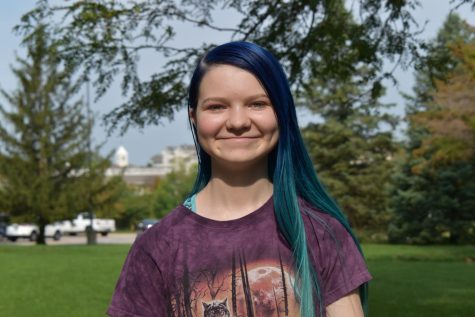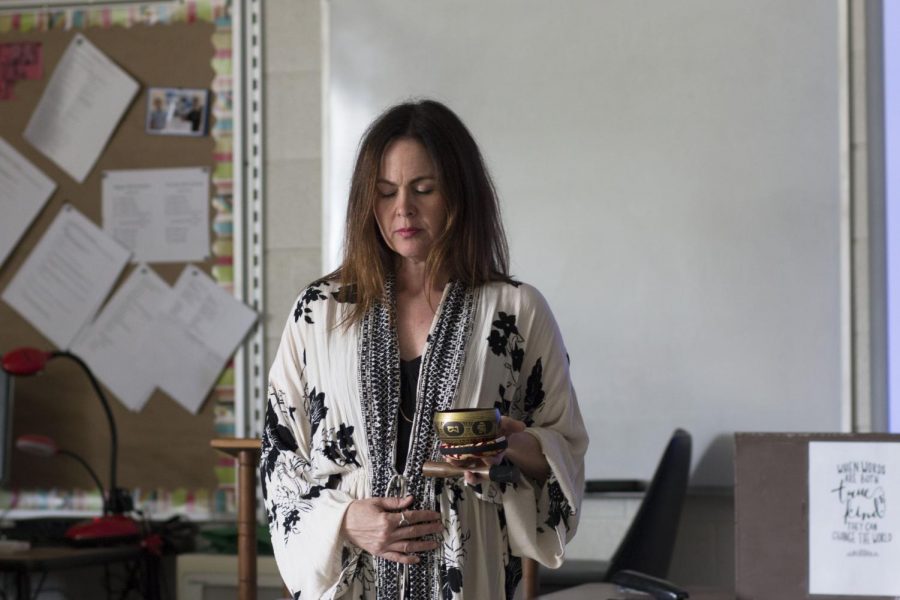Mindfulness and mental health
Teachers Darci Witthoft and Rick Hancox are implementing mindful meditation and discussion circles into West to improve mental health conditions for students.
Darci Witthoft leads a Mindful Minute in her class.
The bell rings for class to start in room 126. English teacher Darci Witthoft walks through the dark room, offering essential oils to her students. Participating students tilt their heads down, chins towards their chests, as Witthoft begins the activity. She walks them through the process of meditation, speaking softly as she has them tilt their heads in a circle and then slowly move their arms from side to side. After the minute of movement, Witthoft has them think of something or someone that brought them joy, before sending the joy out into the world. One last deep breath and the Mindful Minute is over.
Since the beginning of the school year, Witthoft has started almost every class with this activity, known as a Mindful Minute. According to the Greater Good Science Center at UC Berkeley, mindfulness includes being aware of yourself in the present moment and being accepting of yourself. A Mindful Minute is a minute long pause to practice mindfulness.
To start the Mindful Minutes in her classes, Witthoft took multiple courses through Mindful Schools and a six-week long class from Grant Wood AEA. Completely voluntary, the Mindful Minutes are a good way for students to disconnect from the world around them and reflect on themselves.
“In this world where we’re always distracted and connected by so much, you need permission to pause and have a place where you feel like you can just connect with yourself as well as with those around you,” Witthoft said.
Witthoft also holds a longer form of Mindful Minutes in her AFT on Fridays, known as Mindful Fridays. Instead of simply a minute, Mindful Fridays are five minutes of silent reflection and movement followed by a discussion in the form of a circle.
“We’ll talk about … how they felt during the meditation, what are some emotions that came up and how did that feel to sit with those emotions,” Witthoft explained. “Sometimes we talk about topics that are a little private or sensitive, and other times, they’re just … more light-hearted.”
While Witthoft herself has been meditating for a couple of years, she did not decide to implement meditation into school until the beginning of second trimester. She made this decision after attending a seminar from the United Action for Youth (UAY) on mindful movement with several other teachers. The student family advocates at West, Jamie Schneider and John Roarick, helped Witthoft set it up and spread the word. Mason Carter ‘20 was one student who gained interest in the sessions. Since the first couple of Fridays, Carter has been coming regularly.
“It really allows you to destress and focus on things that make you happy [and that] make you relaxed going into the weekend,” Carter said.
In Mindful Fridays, instead of having Witthoft walk the students through the mindfulness, the group listens to a recording on an app called Insight Timer. The recordings range from five to 10 minutes long.
“My favorite part isn’t actually the words said, but the soothing voice,” Carter said. “It really allows you to relax. And [the recordings are] all about … thinking about breathing [and] thinking about … times that you felt happy.”
Carter is one of five people that participate each week. While the group is small, the participants are passionate about the sessions. The participants either request themselves or are already in Witthoft’s AFT. At the beginning of the year, Witthoft did not have an AFT, which meant the sessions were very private. However, due to the change in AFT, Witthoft now has an AFT, so the Mindful Fridays are no longer as private as they used to be.
“it’s not as private as it was and that’s good and bad,” Witthoft said. “[However,] the recipe for success is that you need consistent time, and you need a place that is conducive to meditation and quiet, so you can focus.”
To solve this problem, Witthoft has considered starting Mindful Fridays in the mornings before school. But for now, Witthoft’s main goal with the Mindful Fridays is to increase their reach and turn it into a student-led activity.
“[Mindful Friday is] in its infancy stages, and I hope it grows,” Witthoft said. “I hope we get some strong student leadership, students that are interested that want to take on the Mindful Fridays.”
Aside from mindful meditation, Witthoft is also involved in a monthly circle of about 15 teachers at West, coordinated by Special Programs teacher Rick Hancox.
“The circles we’ve been doing here at West [have been going on] for about a year and a half now … My goal is to introduce a different way to build a better community here at West High,” Hancox said. “We started with teachers because I think teachers really need to understand and buy into the process first before you expect students to buy into it.”
Hancox started circles after a class just like Witthoft did. His class was with Kay Pranis, a national trainer of circles in the US. Hancox wanted to be trained in circles to help his teaching, but after the three-day training process, he realized he wanted circles to be integrated further into the school.
“When you leave circle, sometimes it’s like, ‘Wow, that was just awesome,’” Hancox said. “I wanted our students here to feel that way. And then it became not just about my students in my class, or me, or the people I work with, but to me [it] was like, ‘No, this has to be West.’ This is how it should be.”
Hancox started with the teacher circle only a few days after his training. Since then, he has helped teachers start their own circles in their classes. To him, one of the most important things about circles is getting to know everyone else in the circle. From there, circles can be used to talk about a multitude of subjects.
“I’ve discovered, that many students suffer from a variety of different mental health issues [including] depression and anxiety. And I think they feel alone. [The circle is] an intentional space that’s created to allow for all sorts of different types of conversations, whether it’s just community building or relationship building, to dealing with more serious issues within the school [like] racial issues or gender issues,” Hancox said.
While circles tend to be about broader subjects than just mindfulness, a full circle often starts with a Mindful Minute. Not only that, but both circles and mindfulness share the same goal of improving students’ mental health.
“[The teacher circle] started … some mindfulness activities a year ago … And [Witthoft] has really stuck with it, and really believes in it,” Hancox said. “There’s research out there to show that students that are able to have the ability to practice mindfulness in some way tend to be calmer and are more likely to be able to focus more in school, which helps with … your academic skills and success.”
Your donation will support the student journalists of West High School. Your contribution will allow us to purchase Scholarship Yearbooks, newsroom equipment and cover our annual website hosting costs.

(she/her) Bess Frerichs is the online managing and feature editor. As a senior, this is her third and final year on staff. She enjoys reading, writing...



